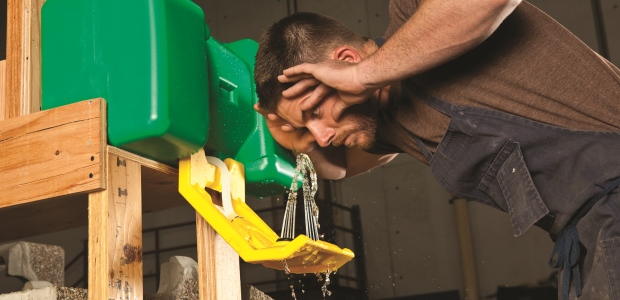
- #Eyewash station inspection requirements ansi install
- #Eyewash station inspection requirements ansi skin
- #Eyewash station inspection requirements ansi free
Likewise we are aware that many organic chemicals (such as acid halides, phenols, and so on) are corrosive and often toxic.
#Eyewash station inspection requirements ansi skin
Submit questions regarding safety in K–12 to Ken Roy at or leave him a comment below.As lab managers and employees, we know that many inorganic chemicals (such as the mineral acids and alkalis) are corrosive to the skin and eyes. A work record of these inspections should be kept. The annual inspection, as recommended by the ANSI standard, should check for problems such as valve leakage, clogged openings and lines, and adequate fluid volume. The custodian is usually responsible for inspecting and activating the emergency shower, eyewash station, and drench hoses each week.

#Eyewash station inspection requirements ansi install
The installation and maintenance and training are the same as those of emergency showers and eyewash stations.Ĭontractors who install these units, facility managers, and/or safety compliance officers have the responsibility to certify that the emergency eyewash and showers meet the ANSI Z358.1standard. Drench hoses flush the eyes, face, and body. These schools may opt for the drench hose system instead, as long as it meets the performance requirements in the ANSI Z358.1standard.Ī drench hose is a supplemental device connected to a laboratory sink.
the removal of any protective devices, including eye and face protection and protective clothing, must not require a separate motion by the user.įor some schools, emergency shower and eyewash stations may be outside of their budget. shower heads and flushing fluid units must be covered with plastic caps to protect them from airborne contaminants. stations should deliver 1.5 liters per minute of tepid water for 15 minutes, at 20.7 Newtons per square centimeter. eyewash stations should be 15.2 cm from the wall or nearest obstruction. the fluid should flow between 83.8 to 134.6 cm from the work surface. valves should activate in one second or less. eyewash stations must provide tepid flushing fluid (15.6–37.8☌ or 60–100☏). The specifications, however, are a bit different. The installation and maintenance and training requirements for eyewash stations are virtually the same as emergency showers’. showers must have tags with the date of the last inspection printed on them. all showers must be inspected annually to make sure they meet ANSI Z358.1 performance requirements. all employees must be trained to use the equipment prior to working with or near hazards. plumbed emergency showers must be flushed weekly to make sure they operate correctly. provisions must be made to prevent an unauthorized shutoff, if shutoff valves are installed in the supply line. #Eyewash station inspection requirements ansi free
the pathway to the shower must be free from obstructions. showers must be located in the same room as the hazard, in a well-lit area with appropriate signage and within reach to hazards such as caustic acids. the center of the spray pattern must be located at least 40.6 cm from any obstruction. 

flow rate should be equal to 75.7 liters/minute for a minimum of 15 minutes at 20.7 Newtons per square centimeter.the spray pattern will have a minimum diameter of 50.8 cm at 152.4 cm above the work surface.the shower heads should be positioned from 208 to 244 cm above the work surface.
 the valve can be activated in one second or less. the shower must provide tepid flushing fluid (15.6–37.8☌ or 60–100☏). The ANSI/ISEA Z358.1 standard suggests that: To make sure, conduct a hazards analysis and risks assessment to determine if a shower might also be needed. Note: Some elementary science classrooms with limited use of hazardous chemicals might only require an eyewash station. That’s because laboratory accidents require a continuous flow of water for at least 15 minutes. Science labs and lecture rooms should only use plumbed showers (which are connected to a continuous source of drinking water) instead of self-contained showers (which contain their own flushing fluid). But which ones should they choose, and how should they be installed, operated, and maintained? The best place for answers is the American National Standard for Emergency Eyewash and Shower Equipment (ANSI/ISEA Z358.1). Most science teachers know that emergency showers and eyewash stations are needed in the presence of potential biological, chemical, and physical hazards.
the valve can be activated in one second or less. the shower must provide tepid flushing fluid (15.6–37.8☌ or 60–100☏). The ANSI/ISEA Z358.1 standard suggests that: To make sure, conduct a hazards analysis and risks assessment to determine if a shower might also be needed. Note: Some elementary science classrooms with limited use of hazardous chemicals might only require an eyewash station. That’s because laboratory accidents require a continuous flow of water for at least 15 minutes. Science labs and lecture rooms should only use plumbed showers (which are connected to a continuous source of drinking water) instead of self-contained showers (which contain their own flushing fluid). But which ones should they choose, and how should they be installed, operated, and maintained? The best place for answers is the American National Standard for Emergency Eyewash and Shower Equipment (ANSI/ISEA Z358.1). Most science teachers know that emergency showers and eyewash stations are needed in the presence of potential biological, chemical, and physical hazards.








 0 kommentar(er)
0 kommentar(er)
